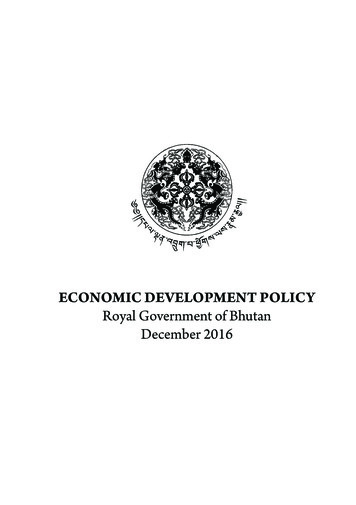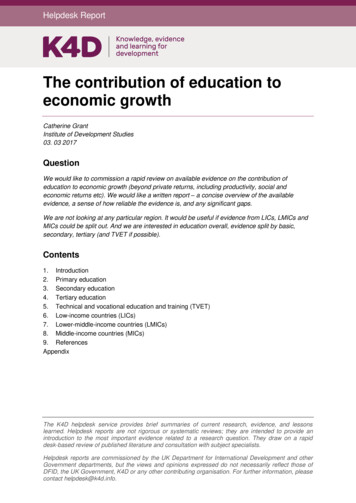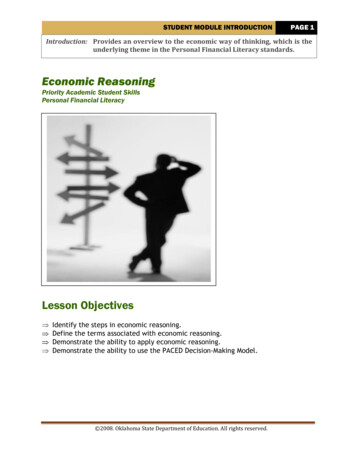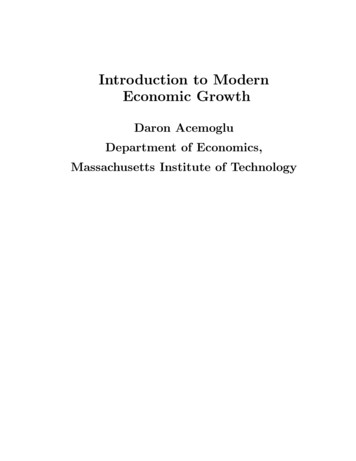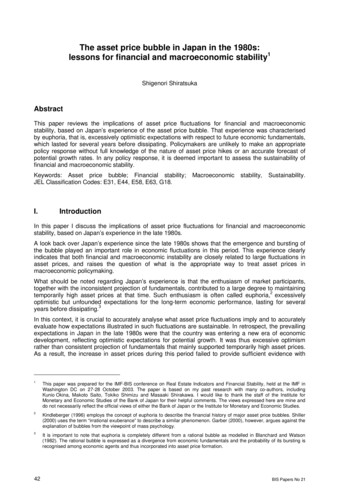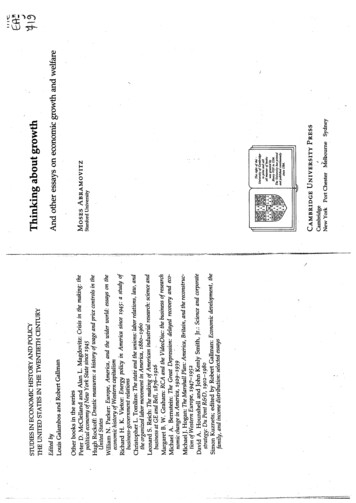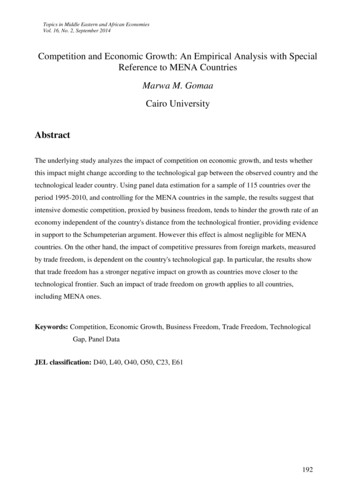
Transcription
Topics in Middle Eastern and African EconomiesVol. 16, No. 2, September 2014Competition and Economic Growth: An Empirical Analysis with SpecialReference to MENA CountriesMarwa M. GomaaCairo UniversityAbstractThe underlying study analyzes the impact of competition on economic growth, and tests whetherthis impact might change according to the technological gap between the observed country and thetechnological leader country. Using panel data estimation for a sample of 115 countries over theperiod 1995-2010, and controlling for the MENA countries in the sample, the results suggest thatintensive domestic competition, proxied by business freedom, tends to hinder the growth rate of aneconomy independent of the country's distance from the technological frontier, providing evidencein support to the Schumpeterian argument. However this effect is almost negligible for MENAcountries. On the other hand, the impact of competitive pressures from foreign markets, measuredby trade freedom, is dependent on the country's technological gap. In particular, the results showthat trade freedom has a stronger negative impact on growth as countries move closer to thetechnological frontier. Such an impact of trade freedom on growth applies to all countries,including MENA ones.Keywords: Competition, Economic Growth, Business Freedom, Trade Freedom, TechnologicalGap, Panel DataJEL classification: D40, L40, O40, O50, C23, E61192
1. IntroductionCompetition is of great importance to the functioning of market economies. It helps create anenvironment that enhances efficiency. It enhances allocative efficiency by securing thatsupply conforms to consumer preferences and resources are directed to their most valued use.It enhances productive efficiency by minimizing production costs. and enhances dynamicefficiency by setting incentives for the development of new products and productiontechniques. Hence, for politicians and policymakers, competition is not a goal per se, but ameans to stimulate more efficiency, which in turn contributes to improved productivity,accelerated economic growth and higher consumer welfare (Don et al., 2008).Nevertheless, the beneficial functioning of competition is not secured spontaneously, butrequires support by state action by setting and implementing appropriate competition policy(Voigt, 2009). Competition policy comprises the set of measures and instruments used bygovernments to safeguard and promote competition in markets. A comprehensivecompetition policy has two main components. The first one includes competition law and itseffective implementation to prevent anti-competitive behavior by businesses, rule out theabusive market behavior of a dominant firm, regulate potentially anti-competitive mergersand minimize unwarranted government controls. The other component refers to a set ofdifferent policies designed to ensure the satisfactory functioning of a market economycomprising relaxed industrial policies, liberalized trade policy, privatization, favourable entryand exit conditions and a greater reliance on market forces (Krakowski, 2005, Sengupta andDube, 2008).In recent years, there has been a widespread trend towards markets liberalization and theadoption of competition policies. The ultimate objective of competition policy is generallyagreed to be the attainment of economic growth, through the impact of the former on marketcompetition. In this context, competition is an intermediate objective and economic growth isthe final goal (UNCTAD, 2010). However, the link between competition policy andeconomic growth is neither straightforward nor clearly distinct in terms of observed reality.The extent to which economies of countries that have adopted competition policies areperforming better than those still to adopt is not quite apparent (Dube, 2008). Such an unclearrelationship could be attributed to two main issues: the controversial relationship betweenmarket competition and economic growth, and the presence of obstacles to the effectiveimplementation of competition policies.193
On one hand, a fundamental divorce has been noted between theorists and empiricists whowork on the relationship between competition and economic growth. While some earlymodels of endogenous technical change predict that competition will curb innovation, in linewith the Schumpeterian theory, more recent research points to competition and the policiesaffecting it as important determinants that spur productivity growth (Bourlès et al., 2010). Onthe other hand, many countries face different hurdles which render the implementationprocess of competition policies less efficient in a way that leaves competition non-existent inmost markets. In fact, it is harder to implement competition policy in developing countriesthan in developed ones. This is due to various market characteristics and enforcementdifficulties, including the presence of large informal sectors, nexus between governmentofficials and large firms, ineffectual rule of law, absence of competition culture, capacityconstraints, high transaction costs and unfavourable business environment (UNCTAD, 2010).Against this background, the current study seeks to analyze the effects of competition oneconomic growth, and test whether this impact depends on the technological distancebetween the country under consideration and the country which is the technological leader.This analysis is important in order to verify whether competition-enhancing policies can helpaccelerate economic growth, and to derive implications regarding the appropriate design andrequirements for the effective implementation of such policies. In this regard, the studyadopts a macro-level analysis to capture the economy-wide effects of competition, sincecompetition policies are usually conducted in a uniform way without distinction amongindustries. Accordingly, the general framework of the underlying work complements theorientation of other studies interested in the impact of sector regulation on productivitygrowth of certain industries or sectors.The remainder of the paper is organized as follows: Section 2 presents a brief review of theexisting literature regarding the relationship between competition and economic growth.Section 3 outlines data and methodology, then presents the empirical analysis and discussesthe results. Finally, section 4 concludes with policy recommendations.194
2. On the Effects of Competition on Economic Growth: A Review of the Literature2.1 Theoretical BasisAccording to standard economic theory, competition is defined as a market situation in whichsuppliers strive for consumers in a way that induces them to become more efficient andcapable of offering a wide variety of products and services at lower prices. Economists havelong been interested in analyzing the role of competition for innovation and economicgrowth, hence, many theoretical arguments as well as empirical studies trying to explain suchrelationship were presented in literature. In general, theoretical models identify two opposingeffects regarding the role of competition for innovation and growth.Conventional wisdom - dating back to Adam Smith - predicts that competition induces abetter allocation of resources and spurs efficiency, which ultimately increases consumerwelfare and promotes economic growth. In a competitive market a product will be offered ata price based on the competition between different suppliers, while if there is no sufficientcompetition, as in the case of a monopolized or cartelized economy, market participants mayobtain dominant market positions that allow them to set higher prices in their favor, hinderingallocative efficiency from materializing which in turn leads to lower growth rates. Moreover,the fight for and the defence of monopolies may lead to a misallocation of investments, whichfurther results in a loss in economic efficiency (Romero, 2003, Voigt, 2009, Petersen, 2013).On the other hand, Schumpeter (1942) claimed that monopolies are more innovative thanfirms with small or even negligible market shares since they are able to offer their products ata higher price than in a competitive market, which will allow them to reap greater returns totheir innovations. Consequently, Schumpeter argued that competition is detrimental toinnovation and thus hampers rather than foster economic growth, as it reduces suchmonopoly rents that reward successful innovators and thereby discourages R&D investments,whereas monopoly market structures would lead to higher rates of innovation andsubsequently growth pointing to a tradeoff between static and dynamic efficiency.Schumpeter's hypothesis has been used to justify the creation of national champions (Voigt,2009).Amid the above arguments, Aghion et al. (1997) and Aghion et al. (2001) extended theSchumpeterian growth framework and managed to develop new models of competition andgrowth by introducing the possibility that more competition could be conducive to innovation195
and economic growth through the "escape-competition" effect. More precisely, competitionmay increase the incremental profits from innovating, and thereby encourage R&Dinvestments aimed at "escaping competition", particularly in sectors where incumbent firmsare operating at similar technological levels; i.e. "neck-and-neck" sectors, since intensivecompetition between firms will increase each firm’s incentive to acquire or increase itstechnological lead over its rivals.Furthermore, new endogenous growth models introduce the notion of "technologicaldistance" and underline its significant role in determining the impact of competition oninnovation. They postulate that competition could have opposite effects on innovationincentives depending on whether firms were initially closer to or farther below the fringe inthe corresponding industry. In particular, new endogenous growth models predict thatcompetition should be growth-enhancing in sectors where incumbent firms are close to thetechnological frontier and/or compete "neck-and-neck" with each other, since in those sectorsthe "escape competition" effect should be the strongest. On the contrary, competition reducesinnovation incentives and therefore productivity growth in industries where innovating firmsare far below the frontier, as the Schumpeterian effect is more likely to dominate in thesesectors (Aghion and Howitt, 2005).In light of the above, it is clear that there is no consensus in the literature on the effects ofcompetition on growth, yet the aforementioned arguments assure that economists dorecognize the fact that the nature of competition prevailing in the market will have an impacton innovation and growth. This in turn implies that adopting competition policy to inducecompetition will affect the incidence of innovations, and accordingly will influence economicgrowth. Subsequently, it became widely accepted among scholars and policymakers thatgrowth-enhancing competition policies require careful assessment of a country's economic,social and institutional setup, which will affect both the design as well as the implementationof such polices.In this context, Aghion and Howitt (1998) build upon Gerschenkron’s idea of "appropriateinstitutions" and emphasize the role of "technological distance" in the growth process;claiming that different institutions or policy designs will affect productivity growthdifferently depending on a country’s distance to the world technological frontier (Aghion andHowitt, 2005). Along the same line of thought, the recent literature on endogenous growththeory, based on Acemoglu et al. (2006), indicates that the distance from the technological196
frontier is the key to determining the growth-enhancing economic policies to be adopted. Theargument is based on the following reasoning: For countries with low levels of technologyi.e. far from the frontier, it is recommended that they follow an imitation-based economicpolicy to exploit the results of existing innovations. In terms of competition policy, thismeans that trade liberalization is more favorable for these countries in order to attract foreigndirect investment and promote technological progress through the adoption of foreigntechnologies. On the contrary, business liberalization in this stage discourages investing inresearch and development and hence innovation, since the higher entry threat oftechnologically advanced firms decreases the incumbent’s expected pay-off from innovating.On the other hand, as countries get closer to the technological frontier, the economic policyadopted should aim at promoting innovation in order to invent new products and productiontechniques or improve the quality of the existing ones. Within competition policy context,this implies that business liberalization is more beneficial for such countries, since theincreased possibility of entry in the market and thus the higher potential competition from theincumbent firm incentivizes both the incumbents and the entrants to invest more ininnovation, as it offers the only way to survive in the market (Scopelliti, 2009).2.2 Empirical LiteratureThe impact of competition on innovation and economic growth has largely been exploredempirically, both at micro and macro levels. Early empirical literature was pioneered by thework of Scherer (1967), followed by Cohen and Levin (1989), and more recently by Geroski(1995), Nickell (1996) and Blundell et al. (1999). Those papers employed linear estimationsand they all point to a positive correlation between competition and growth, while usingseveral alternative measures of competition, including the inverse of market concentration,the inverse of the Lerner index or the number of competitors for each firm in the survey.However, none of these studies reveal the reasons why competition can be growth-enhancingor why the Schumpeterian effect does not seem to hold (Aghion and Howitt, 2005).Deeper empirical analysis was undertaken by employing non-linear estimations, andsubsequently an inverted-U relationship between competition and growth has been capturedin different empirical studies; showing that an increase in competition initially increasesgrowth, but reduces it beyond a threshold level. Using firm-level data, Scott (1984) found aninverted-U relation between R&D intensity and market concentration, when not controlling197
for industry characteristics, while Levin et al. (1985) reported a similar pattern at the industrylevel. Later, Aghion et al. (2002) showed a strong bell-shaped relationship betweencompetition and innovation by analyzing a group of industries in the UK in the period 1968–1997. However, these studies are confined to firm and industry level analyses and do notcapture the economy-wide effects of competition.Several studies try to focus on measuring the effect of competition policy on economicindicators such as economic growth, productivity, and the level of competition. Dutz andHayri (1999) developed different sets of variables related to policy, structure and mobility inan attempt to provide a richer picture of the intensity of economy-wide competition.Conducting a cross country study, they find that measures of effective competition policy arepositively associated with higher rates of economic growth. Nevertheless, they reported thatthis link appears to be more tenuous for Far Eastern economies. Also, their constructedvariables are based on subjective evaluations of surveyed businesspeople which might havesome drawbacks.Dutz and Vagliasindi (2000) try to get away from subjective perceptions of competition andevaluate the effectiveness of competition law implementation in 18 transition economies ofEastern Europe and the former Soviet Union, based on the level of law enforcement,competition advocacy, and institutional-related activities. In their cross-sectional study, theyfind a positive relationship between effective competition law implementation and expansionof more efficient private firms in the observed countries. Yet, the data is just available for afew countries.Also, Voigt (2009) estimates the effects of competition law implementation on growth. Heproposes a number of indicators on various aspects of competition laws and antitrustauthorities that help assess the effectiveness of antitrust regimes in practice. Based on asurvey of the activities of various antitrust agencies, he comes up with four indicatorsconcerned with the objectives and instruments of competition laws, the formal basis of theregime, namely the use of economic methods, as well as the de jure and the de factoindependence of the antitrust authority. Using cross-sectional data, Voigt reports that all fourvariables contribute to explaining differences in total factor productivity. Although the newconstructed indicators estimate the effectiveness of an antitrust regime better than the mereevaluation of the “law in the books,” their impact is not robust to the inclusion of indicatorsfor the general quality of institutions, as reported by the study. In addition, they are not198
available in time-series data to allow for tracking the long-term effects of competition lawimplementation on growth.Furthermore, Buccirossi et al. (2012) construct an index for the effectiveness of an antitrustregime based on evaluating different elements of antitrust laws and agencies, such as theindependence of antitrust authority, their investigation powers, their budget, and the potentialsanctions for antitrust violations. Using the newly created index, the study report a positiveand significant effect of competition law on the growth rate of total factor productivity for 22industries in twelve OECD countries over the period 1995–2005. Again, this index onlycovers a few countries.Other studies also show opposing trends. For instance, Winston and Crandall (2003) presentseveral case studies to assess the effects of antitrust policy and enforcement on consumerwelfare. They show that antitrust regulation in the areas of monopolization, collusion, andmergers does not influence the development of market prices and hence does not benefitconsumers; rather they find evidence that it may have lowered consumer welfare in somecases. Furthermore, Young and Shughart (2010) analyze annual time series data over theperiod 1947-2003 on three measures of federal antitrust law and report evidence that antitrustinterventions act like negative technology shocks to productivity growth, and that antitrustpolicy does not generate subsequent offsetting net increases in productivity.Following the relevant theoretical propositions, the concept of "technological distance" isalso considered in recent empirical studies that try to analyze the effect of antitrust regulationon productivity and innovation, depending on the distance to technological frontier.Acemoglu et al. (2006) use cross-country panel data to show that high barriers to entrybecome increasingly detrimental to growth as the country approaches the frontier.Accordingly, they argue that less competitive environments may foster growth at early stagesof development (i.e. in countries far from the frontier), but later will hamper growth andprevent convergence to the frontier. Similarly, Aghion et al. (2009) find that the threat oftechnologically advanced entry increases innovation incentives in sectors close to thetechnology frontier, where successful innovation allows incumbents to survive the threat, butdiscourages innovation in laggard sectors, where the threat of entry reduces incumbents’expected rents from innovating. Also, Scopelliti (2009) finds business liberalization to bemore useful for countries close to the technology frontier, while trade liberalization is more199
beneficial for those farther from the frontier, suggesting that trade liberalization shouldprecede business liberalization in developing countries.In summary, it can be said that the relationship between the overall intensity of competitionin an economy and its long run growth is an open question in economics. The literature isquite diverse and does not offer a clear-cut answer. This is also true for the effects ofcompetition policy on the intensity of competition and growth. Accordingly, this issueremains of mounting interest, offering an ample field for further empirical analysis in thisregard.3. Estimation Approach and the Discussion of Results3.1 Econometric SpecificationThe study employs a panel data approach to analyze the impact of competition on economicgrowth for 115 countries over the period 1995-2010; while considering the role of distancefrom the technological frontier in the growth process, i.e. studying whether the effect ofcompetition on growth may change depending on the technological gap between the observedcountry and the technological leader country, and controlling for the MENA countries1 in thesample.More formally, the general specification of the regression function is as follows:((where))is a measure of economic growth in country i at time t,a measure of competition in country i at time t-1,country i at time t-1,is the technological gap foris an interaction term between the measure ofcompetition and the technological gap for country i at time t-1,variables,is a dummy variable for MENA countries,is a vector of controlis an interaction termbetween the measure of competition and the MENA countries dummy at time t-1, and1isisThe study adopts a broad definition of the MENA area including the following countries: Algeria, Bahrain,Cyprus, Djibouti, Egypt, Iran, Iraq, Israel, Jordan, Kuwait, Lebanon, Libya, Malta, Morocco, Oman, Qatar,Saudi Arabia, Sudan, Syria, Tunisia, Turkey, United Arab Emirates, West Bank and Gaza, and Yemen.200
the error term. Below is a detailed description for the variables used in the model. Table 1 inthe appendix reports the preliminary statistics for all variables.The Dependent VariableThe dependent variable used in the empirical analysis to reflect the economic growth of acountry is the growth rate of GDP. This indicator is appropriate to analyze the economy-wideeffects of competition, and thus serves the purpose of the study in deriving recommendationsabout the appropriate design and implementation of growth-enhancing national competitionpolicies. Data on GDP growth rate is obtained from World Development Indicators (WorldBank, 2013).The Explanatory VariablesCompetition depends mainly on barriers to entry that may prevent new firms from accessingthe market. A fundamental precondition for the existence of intensive competition is thatmarket entry is fairly easy. This should apply for both domestic and foreign entrants. Thus,competition should be correlated with the absence of bureaucratic impediments to open newbusinesses and barriers to international trade. Accordingly, the business freedom index andtrade freedom index are suggested as proxies for competitive pressures from domestic andforeign markets respectively. The two indices are among the components of the economicfreedom index computed yearly by the Heritage Foundation. The main advantage of theseindices is that they are available for a large number of countries and for a significant timeseries, so they can be used to analyse the economy-wide effect of competition on growth in adynamic perspective.Business freedom is an overall indicator of the efficiency of government regulation ofbusiness. The quantitative score for each country ranges between 0 and 100, with 100equaling the most free business environment. The score is derived from ten factors measuringthe difficulty of starting, operating, and closing a business, based on data from the WorldBank’s Doing Business study. The Index of Business Freedom is thus proposed as anindicator of the competitive pressures from the internal market due to the existence of otherproducers or the entry of new firms.Trade freedom is a composite measure of the absence of tariff and non-tariff barriers thataffect imports and exports of goods and services. The trade freedom score is based on two201
inputs, namely, the trade-weighted average tariff rate and non-tariff barriers. The quantitativescore for each country ranges between 0 and 100, with higher scores corresponding to lowerbarriers. Accordingly, the trade freedom index is suggested as a measure of the possiblecompetition coming from the external market through the supply of foreign productsimported without trade barriers.Also, based on recent empirical literature on competition and growth, this work takes intoaccount the distance from the technological frontier as a possible determinant of economicgrowth, both as a single explanatory variable, and also as a factor of an interaction term withboth business freedom and trade freedom indices to explore whether the effect of competitionon economic growth may change depending on the level of the technological gap between theobserved country and the country which is the technological leader. There are several wayswhich can be used to measure the technological gap. Constrained by data availability, theunderlying study follows the existing literature and use labour productivity to compute thetechnological gap. The leader country (technological frontier) is identified as the country withthe highest labour productivity in the sample, while the technological gap is calculated as theratio of labor productivity of the country under consideration to the labor productivity in theleader country (Scopelliti, 2009). Accordingly, the technological gap variable ranges from 0to 1, with lower values indicating larger gaps. Labour productivity is measured as GDP perperson employed (constant 1990 PPP ), and is obtained from the World DevelopmentIndicators.The business freedom, trade freedom and technological gap variables are all lagged by oneperiod with respect to the dependent variable. This is done in order to avoid endogeneityproblems for the explanatory variables, and also to account for gradualism in the effects ofbusiness freedom and trade freedom on the growth process, since the impact of entry onincumbent firms' incentives to innovate is not instantaneous, and hence there must besufficient time until the effects on economic growth are notably realized.We control for MENA countries by adding two variables: a dummy variable that takes thevalue 1 for those countries and 0 otherwise, and also an interaction term between the businessfreedom/trade freedom index and the MENA countries dummy to test whether the effect ofcompetition on economic growth differs in MENA countries than in the rest of the world. Theempirical analysis will also include some control variables in order to take into account otherpossible determinants of economic growth, such as the level of investment measured by gross202
capital formation as a percentage of GDP, trade openness measured as the summation ofexports and imports relative to GDP, the population growth rate, the inflation rate calculatedas the annual percentage increase in consumer prices, and government consumptionexpenditure as a percentage of GDP. Data for the control variables are obtained from theWorld Development Indicators.The econometric strategy followed for testing the relationship between economic growth andcompetition is to estimate a panel data model. In particular, a random effects model isemployed to control for the MENA countries using a dummy variable. In general, a randomeffects model generates more efficient estimates with higher statistical significance thanestimates computed through a fixed effects model.3.2 Estimation ResultsTable 2 presents the regression results when the business freedom index is employed as themain explanatory variable used to proxy competitive pressures from the domestic market.Column 1 depicts a baseline model where only the impact of business freedom andtechnological gap on economic growth is tested. The results of this model show a negativeand significant impact of both variables on GDP growth rate. This implies that more domesticcompetition slows economic growth, in line with the Schumpeterian hypothesis; and also thatthe GDP growth rate is higher for countries far away from the technological frontier than forthe technologically leader economies, as supported by the theory of convergence.In column 2, an interaction term between the business freedom index and the technologicalgap is introduced to study whether the impact of business freedom on GDP growth mightchange according to the technological gap between the observed country and thetechnological leader country. The coefficient of business freedom remains negative andsignificant, while the coefficients for technological gap and the interaction term areinsignificant. Business freedom has a negative impact on GDP growth rate and this impact isindependent of the country's distance from the technological frontier.Column 3 depicts regression results when standard economic variables are controlled for. Thecoefficient of business freedom remains negative and significant, while the coefficients forthe technological gap and the interaction term remain insignificant. This indicates that moreintensive domestic competition tends to slow down the growth rate of an economy regardless203
of the country's technological gap. Such results assert the basic Schumpeterian argument ofthe tradeoff between static and dynamic efficiency; where competition discourages theincumbents' incentives to innovate and hampers economic growth by sweeping awaymonopoly rents that reward successful innovators. The standard control variables are allsignificant and have the expected signs. More precisely, we observe that more trade opennessand increased investment enhances economic growth, whereas higher inflation rates and therapid expansion of government consumption expenditures can slow down the growth of theeconomy.We control for MENA countries by introducing the MENA dummy variable, and aninteraction term between the business freedom index and the MENA d
Competition and Economic Growth: An Empirical Analysis with Special Reference to MENA Countries Marwa M. Gomaa Cairo University Abstract . a price based on the competition between different suppliers, while if there is no sufficient competition, as in the case of a monopolized or cartelized economy, market participants may .


